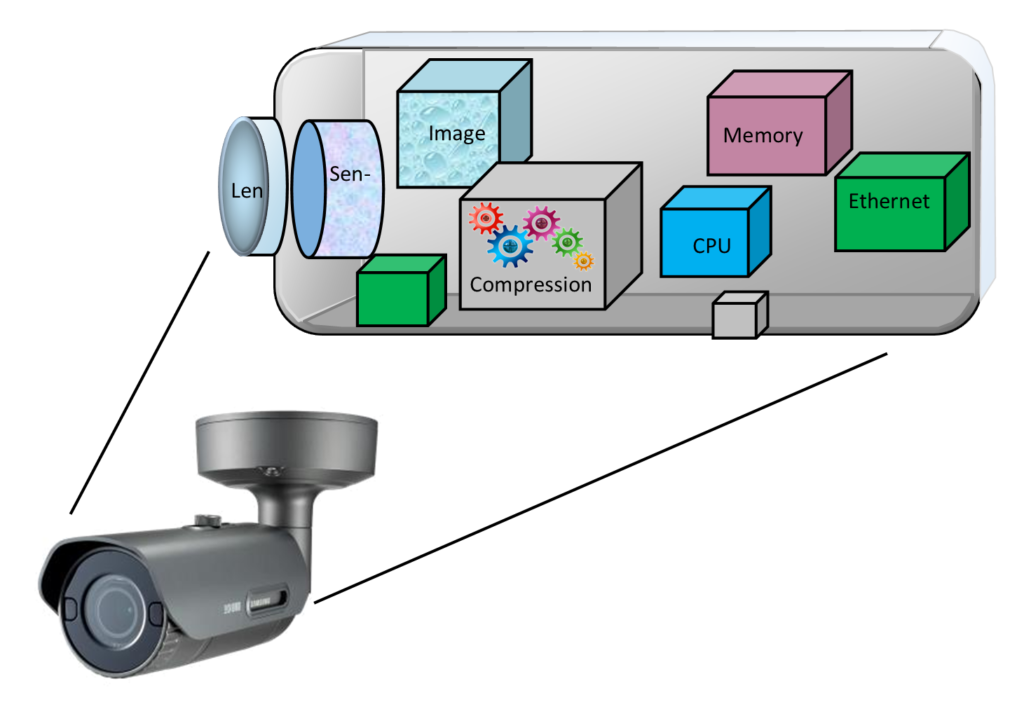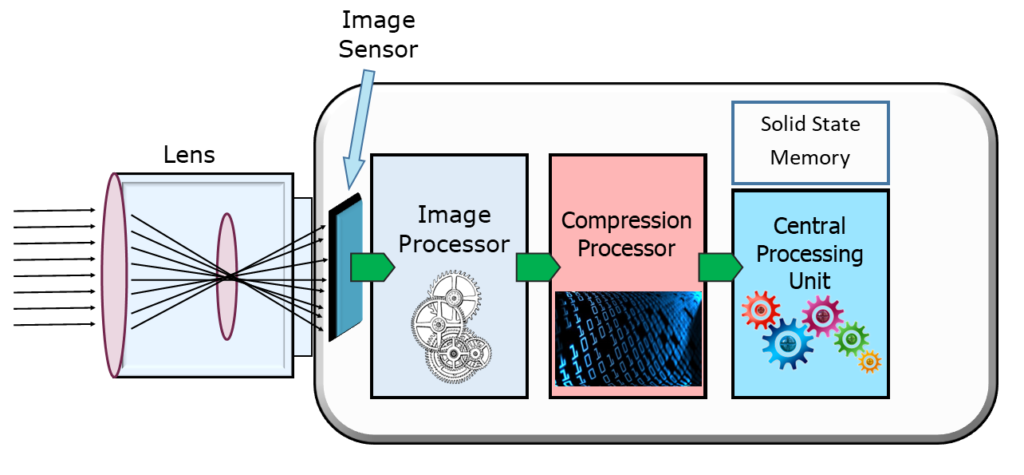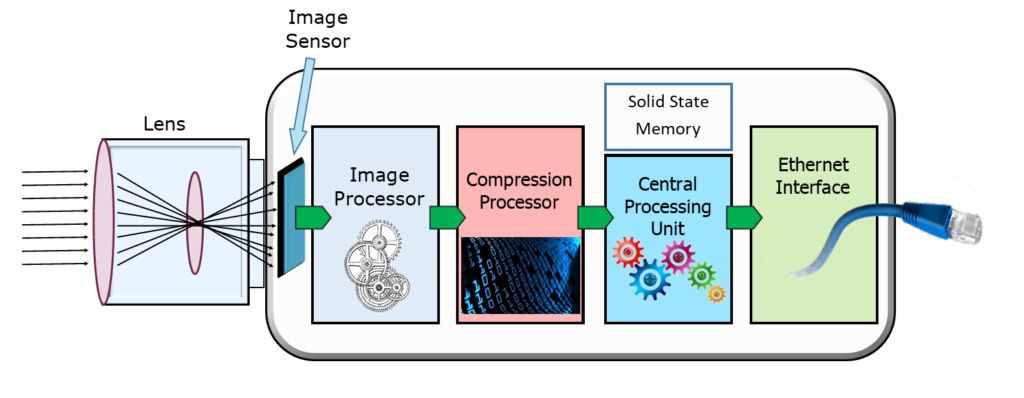The Components of the IP Camera

An IP camera is a surveillance video camera that attaches to the network and is part of an IP Camera System. The cameras are an essential part of the physical security systems and are used in business, government, and educational institutions worldwide. Over the years, they have played a vital role in ensuring safety in all our organizations.
This tutorial describes how the IP camera works.
How the Film Camera Works
To better understand how the IP camera works, let’s start with the old analog film camera. This camera has three fundamental parts, the lens, the shutter, and the film. Yes, there were more parts, but these are the most significant. Here’s how these components worked together.
The Lens of the Camera
The camera lens determines how wide an area you can see or the field of view. The focal length or angle describes the field of view at a certain distance and the magnification of the lens. The smaller the lens angle (or, the higher the focal length (mm)), the more magnification we achieve.

Do you wonder why some lenses cost much more than others? For example, some lenses cost around $50 while others are over $1000. As usual, you get what you pay for. The more expensive lens does a better job transferring the image to the film. The higher quality lens provides better clarity or resolution while providing a better light aperture. If you don’t use a good lens, the picture won’t be as good as expected.

The Shutter of the Camera
The analog or film camera includes a shutter. The shutter opens for a short period to allow light from the lens to reach the film. The longer the shutter is open, the more light gets to the film (or sensor).
The Photographic Film
Do you remember when cameras used film? The film was on a roll and was challenging to use and expensive. You had to take the camera to a dark space before installing the film roll in the camera so that the light wouldn’t ruin the film.
Photographic film has been around since the late 1800s. The early film consisted of an emulsion of light-sensitive silver halide crystals. The film had to be processed to develop all the pictures. Photographic cameras have gone through three major eras: the plate era, the film roll era, and the current digital age.
When we used film, we usually had to wait many days to see our photos. The digital camera became available in the 1990s, which made things a lot quicker. It took several years for the digital components to improve so that the quality of the pictures approached the film quality.
The Digital Camera

As the name implies, a digital camera uses digital components, especially solid-state memory. The image sensor replaces the film. This advancement in photography was not easy. It required the addition of many circuits that processed and stored the image.
The Digital camera includes the lens, and the image sensor replaces the shutter. It also contains additional components such as the image processor, image compressor, central processor unit (CPU), and digital memory.
The Digital Image Sensor
Before the solid-state sensors, there were vacuum tubes. The early analog video cameras used an electronic phototube device called a Vidicon or Plumbicon as the image sensor.
Today most cameras use complementary metal-oxide-semiconductor (CMOS) as the sensor. In a CMOS sensor, millions of photodiodes convert light to a voltage. The signal is multiplexed by row and column to many on-chip digital-to-analog converters (DACs). These digital sensors are available with over 40-Megapixel resolution. See Samsung is making one more giant ISOCELL camera sensor that describes a 50-Megapixel sensor used in Vivo phones.
Please read our article How the CMOS Video Sensor Works in IP Cameras to learn more about the digital camera sensor
The Camera’s Image Processor
The image processor is a specialized computer that provides several image processing functions such as assembling the multiple colors from the sensor into a single color image, smoothing the image created by the individual diodes in the sensor, amplification and noise reduction, and image sharpening. In general, it makes the picture captured by the sensor look better. The image processor can use multiple parallel computers to speed up the processing.
The Camera’s Image Compression
The data collected from the image processor is huge, so it’s essential to compress the information so it can be stored on the memory chip or transferred across the Internet. A specialized computer processor is used to compress the data. The algorithm for video compression is different than that used for images. Examples of image compression include JPEG, PNG, and GIF. Video compression schemes include MJPEG, H.264, and H.265
Central Processing Unit of the Digital Camera
The CPU or Central Processing Unit controls everything that goes on inside the digital camera. It directs the data flow from the sensor, image processing, and compression systems to the memory in the camera. It also provides the user interface and a display showing the camera’s status.
The Camera’s Image Storage and Memory
The digital cameras use standard memory cards to hold the pictures. The images’ resolution and the number of stored pictures determine the size of the memory card required. We also must select memory cards that are fast enough to handle the data flow from the camera’s digital circuits.
IP Video Camera

The IP Camera is similar to the digital camera in that it uses similar types of computers and circuits. The significant difference is the speed of processing the pictures, the compression scheme used, and the addition of an Ethernet interface. Most video IP cameras can handle up to 30 frames per second (fps), with some processing frames at up to 60 fps.
IP Camera Compression Schemes
Compression is handled by a video CODEC (a combination of code and decode). The early IP cameras used Motion JPEG, but the latest IP cameras use H.265 compression, which provides the best compression.
IP Camera System
The IP Camera System consists of many IP cameras, a video storage system, network switches, and routers.
The latest IP cameras are powered using Power over Ethernet (PoE) and are available as a dome, box, bullet, and PTZ cameras. The IP camera is just one component that makes up the complete IP camera system.
The video recording system is either VMS software on your Windows computer or a Network Video Recorder (NVR). It provides management of all the cameras, records the video, and displays all the real-time and recorded video.
Summary of How the IP Camera Works
The IP camera has many of the same functional systems as the digital cameras that replace the film with a digital image sensor. The IP camera includes image processing, compression, data management, and the Ethernet interface. It transfers the video to other computers on the network that display and record the video.
To learn more about IP Cameras, please contact us at 800-431-1658 in the USA or 914-944-3425 everywhere else, or use our contact form.